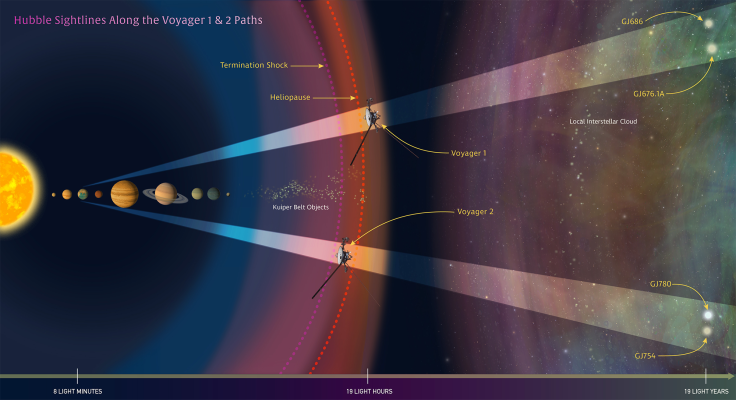NASA’s Hubble Creates A Road Map For Voyagers’ Interstellar Journey

Roughly a decade from now, when they run out of electrical power, the two Voyager spacecraft — Voyager I and Voyager II — will fall silent and stop beaming back data to Earth. Until this happens, however, their journey through interstellar space will continue to provide an invaluable opportunity for astronomers to understand the vast space around our solar system.
As the two spacecraft race through the virgin territory — boldly going where no man has gone before, and probably won’t, in the foreseeable future — NASA’s Hubble Space Telescope is charting their path, providing a road map of the probes’ future trajectories and giving a broader context to what they are observing in their vicinity.
“This is a great opportunity to compare data from in situ measurements of the space environment by the Voyager spacecraft and telescopic measurements by Hubble,” astronomer Seth Redfield from Wesleyan University in Middletown, Connecticut, who recently presented a preliminary analysis of Hubble's observations, said in a statement Friday.
Astronomers hope that Hubble’s observations will help them understand the physical properties of the Local Interstellar Medium — a vast bubble that surrounds the solar system. Voyager II is expected to break through this interstellar cloud in approximately 2,000 years, after which it will spend 90,000 years in a second cloud.
It’s still not clear when Voyager I will exit the Local Interstellar Medium.

“For the next 10 years, the Voyagers will be making measurements of interstellar material, magnetic fields and cosmic rays along their trajectories,” NASA said in the statement. “Hubble complements the Voyagers’ observations by gazing at two sight lines along each spacecraft’s path to map interstellar structure along their star-bound routes. Each sight line stretched several light-years to nearby stars. Sampling the light from those stars, Hubble’s Space Telescope Imaging Spectrograph measures how interstellar material absorbs some of the starlight, leaving telltale spectral fingerprints.”
Analysis of Hubble data collected so far has already provided insights into how our sun travels through interstellar space, and how the heliosphere — a large bubble around the solar system produced by solar winds — interacts with the gas and dust in nearby space.
“The Voyagers are sampling tiny regions as they plow through space at roughly 38,000 miles per hour. But we have no idea if these small areas are typical or rare,” Redfield said in the statement. “The Hubble observations give us a broader view because the telescope is looking along a longer and wider path.”
© Copyright IBTimes 2024. All rights reserved.












